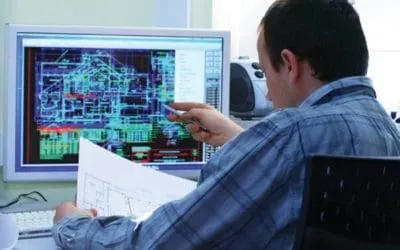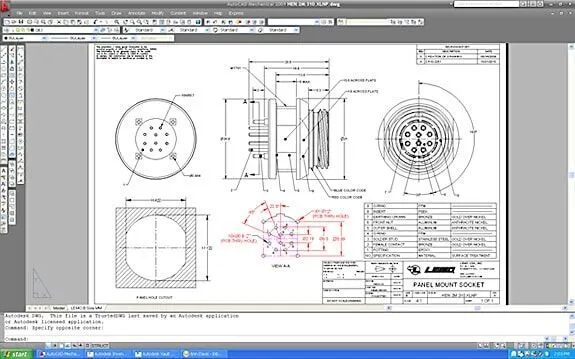Convert Scanned Raster Images to CAD with Shakespeare’s Hamlet
Convert Scanned Raster Images to CAD with Shakespeare’s Hamlet
On a dark winter night, the ghost of technical drawings walks the ramparts of Elsinore Castle…
The ghost resembles the CAD drawings you use today, but this ghost is what is known as a “raster image.” When you scan a technical drawing using a large format scanner, the resulting image is what is known as a raster format.
Usually, the reason that engineering departments scan their paper drawings is to convert them into digital files for easy, permanent storage. Often, however, these drawings need to be referred to and edited or incorporated into new drawings in a CAD system.
To quote Shakespeare’s Hamlet, “Aye, there’s the rub.”
Just as in lawn bowling, where the “rub” is an obstacle that pushes the ball off course, in CAD, the “rub” is two different image types that throw the use of the drawings in a CAD system off course.
Eliminating the CAD “rub”
CAD programs like AutoCAD and others create a vector image which means, simply, an image made of lines. This is in contrast to the raster image that results from scanning paper drawings. Raster images are composed of pixels, so that curved lines in a raster file are actually carefully constructed rectangles that represent a curved line. Whether you are adding an image to your CAD system or you want to edit a scanned drawing, you need to convert the raster file to a vector file.
Raster to Vector (or R2V) is used extensively in commercial and industrial applications to convert technical drawings, maps and other paper graphics from scanned raster files to vector formats. Converting scanned raster images into high-quality CAD files can seem like a time-wasting challenge. But, if you have blueprints or drawings that need to be updated or converted; if you consider your technical data to be a critical asset; if efficient management of this data is important for the functioning of your business, then raster to vector conversion is essential.
“To be or not to be” able to use your scanned drawings depends upon your ability to convert raster images to vector images. “That is the question. “ Are you up to the task of raster to vector conversion?
Outsource and Avoid the “Slings and Arrows”
If Hamlet had the job of converting raster to vector he may well have rued “the slings and arrows of outrageous fortune” and hoped to find a way “to take arms against a sea of troubles and…end them.”
While you will probably be able to load a raster image into your CAD program, once you have imported a raster image into your CAD program you will find that all you can do is look at it or trace over it. You will not be able to make any changes to it. That’s why raster to vector conversion is critical. Once it’s converted to a vector image and you will be able to import it into your CAD program and edit it.
Outsourcing your raster to vector conversion lets your organization focus on the design tasks that are central to your corporate mission and enables you to keep your focus on the money-making aspects of your organization. Outsourcing can often give you a technical and functional edge on the competition, without capital, IT or personal investment. Outsourcing often allows for faster work completion, lower cost, and a better-managed company. Many experts recommend outsourcing as a requirement for successful companies in today’s business environment. Hamlet tells us “‘Tis a consummation devoutly to be wished.”
“Perchance to Dream” of the Perfect R2V Outsource
Where should I outsource? Many organizations think that “outsourcing” is synonymous with sending work offshore. Generally speaking, we recommend finding a U.S. based company with competitive prices, good references, and expert staff.
One of the biggest risks associated with the offshore outsourcing of CAD conversion involves the inflated expectations that the internal organization has about how much the savings from offshore CAD conversion outsourcing will be. Another significant risk with offshore outsourcing for raster to vector conversion is that the vendor may not be able to perform as promised, often as a result of language barriers. Finally, rapid growth among offshore CAD outsourcing vendors has created a dynamic labor market, especially in India. This often results in a rapid turnover of key personnel which can directly affect both the quality and timely delivery of your R2V conversion work. Or, as Hamlet puts it “In this regard (your) currents turn awry and lose the name of action.”
Recent Posts


CAD Outsourcing Doesn’t Have to Be Done In India
CAD Outsourcing Doesn’t Have to Be Done in India Do a Google search for “CAD Outsourcing” and what you’ll find is lots of firms located in India, which is fine if you’re prepared to go off-shore for CAD services. But what if your U.S. based company prefers to stay a...

AutoCAD Fiber Optic Designs & Drawings
Before proceeding forward in explaining the affinity between AutoCAD and Fiber Optic, it would be prudent to rationalize the utility of optical cables. When communicating between systems, either via the internet or via an internal network system, a medium needs to be...

CAD Outsourcing: How to Get the Most Out of Engineering
In today’s competitive market, companies need as much help as possible. If you want to take a larger market share, you can start by outsourcing some of your work. This is a quick way to expand your engineering power without onboarding and training a new staff. This...
